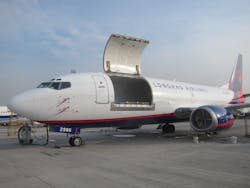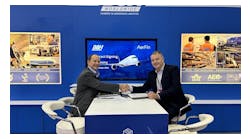Hot Spots Amidst Lukewarm Passenger to Freighter Conversion Market
The passenger aircraft to freighter conversion isn’t quite what it used to be. “Many people have been predicting a rebound…for several years now,” says John F. Smiley III, manager of aviation competitive & market intelligence for CAVOK, a division of Oliver Wyman. “It just hasn’t come through.”
Smiley says there are a couple of key reasons: newer passenger aircraft come replete “with a lot of belly cargo room,” and formerly red-hot “express carriers are under a lot of heavy competition from rail and ground transportation.” This leads the aviation consultancy to forecast 300 to 400 passenger to freight conversions over the next 10 years. Smiley says that number reflects the reality of the market “for all size” conversions.
Market Debate: Size and Scope
Mike Andrews begs to disagree somewhat with CAVOK’s assessment, predicting “a bit better than 400” aircraft according to PEMCO World Air Services’ director of cargo conversions. PEMCO specializes in reconfiguring Boeing 737-300s and -400s for cargo customers. It’s reworked more than 150 of the ubiquitous twin-engine aircraft since the conversion program was launched back in 1991.
Boeing is busy just now with preparations to roll out its first 737-800BCF (Boeing Converted Freighter) soon, with the first conversion set for re-delivery in the fourth quarter of 2017 to the customer. In all, Boeing predicts a total demand for 1,440 converted freighters over the next 20 years — 1,040 standard-body aircraft and 400 wide-bodies.
Seen in aggregate, the conversion market is percolating along. It’s just not steamy hot anymore. “Our market is not slow,” asserts PEMCO’s Andrews. “We’ve had one of the better years we’ve had in the last few years. We’ll convert 10 to 15 this year.”
Boeing says so far it’s received as many as 60 orders for its 737-800BCF from eight customers. A significant slice of those -800s are bound for China, where they’re being converted.
The company set up its first line at Boeing Shanghai, says Kurt Kraft, Boeing’s vice president of freighter conversions. “We’re going to add two additional lines at STAECO in Jinan.” He calls both facilities experienced MRO sites. "We’ve got a great deal of confidence in these guys. It’s a great place to build the airplane and they’re very good at what they do.
“The beauty is there’s a tremendous amount of demand right now for this [-800] airplane in China,” says Kraft. “This allows us to do these conversions close to the customer, so they can stay close to their airplanes during the conversion process.”
By the numbers, the Boeing World Air Cargo Forecast projects world air cargo will grow “4.2 percent over the next 20 years, with domestic China and intra-Asia markets expanding 6.2 percent and 5.5 percent respectively.”
CAVOK’s Smiley puts these numbers in perspective: “The middle class [in China] is the size of the entire U.S. population. So as that middle class continues to increase their spending that will drive a lot of growth.”
Aircraft/Market Match
Drill deeper into that growth and route sectors emerge, some requiring different types of aircraft. In its latest report (2015) Boeing tallied:
• A 1.9 percent air cargo growth worldwide;
• Plus 6.5 percent growth from Asia to North America;
• Plus 6.5 percent growth from Europe to Asia;
• A modest plus 1.3 percent intra-Asia;
• Moderate 1.8 percent growth from Europe to North America;
• A plus 2.5 percent rise in intra-North America cargo traffic;
• A plus 4.9 percent hike in domestic China air cargo;
• A plus 0.6 percent increase in Latin America-Europe air cargo;
• A fall off of 4.1 percent from Latin America to North America;
• A gain of 0.6 percent between Africa and Europe;
• A 4.1 percent decrease between South Asia and Europe;
• An 11.1 percent rise between the Middle East and Europe;
• A growth of 5.0 percent in Intra Europe air cargo.
Among aircraft handling short to mid-range missions are Boeing’s 737-300 and -400s. PEMCO specializes in these conversions.
Boeing says its 737-300SF carry up to 19 metric tons of cargo, sport as many as 10 pallet positions, and can fly as many as 1,600 nautical miles nonstop. Contrast those capabilities with the 737-800BCF which can haul up to 23.9 metric tons of air cargo on routes of up to 1,995 nautical miles. The -800BCF boasts 12 pallet positions.
The battle between older 737-300s and -400s on one hand and newer 737-700s and -800s on the other is being closely watched. Smiley says, “What [operators] look at is the total cost of operation. So, you can operate the 737-300 and 737-400 — even though they cost more per hour to [fly], the acquisition cost of getting that aircraft and the conversion cost may make it beneficial vs. a new 737-700 or -800, because of the lower utilization.”
OK, but just how much of this operational advantage is due to the current cost of jet fuel? It’s not dirt cheap, but it’s still sane. Smiley says, “[We] did an analysis of this a few years ago and we determined that for narrow-body aircraft fuel has to be about US$2.00 per gallon before the new generation of narrow-bodies become more efficient … Fuel has just now crept back up to about US $1.50. It’s still got a ways to go.”
PEMCO’s Andrews says the older-generation airframes his company converts average between 35,000 and 45,000 cycles when they roll into the hangar. The No. 1 driver among his customers is aircraft acquisition cost, coupled with the consideration of “What they’ve got to put back in the aircraft so that it will fly another 10 years.”
The market for passenger to freighter conversion is firmly focused on the 737 family, with the -800 the most attractive conversion candidate just now. Smiley says the Seven-Threes are supplemented by other conversions: some of the remaining 757s and 767s as well as the first batch of A320s coming off passenger operations. Even relatively venerable MD-80s are getting the conversion treatment. Aeronautical Engineers Inc. (AEI) is transforming a third MD-80 series twinjet to an MD-83SF freighter. The twinjet is capable of accommodating a dozen main deck containers or pallets and will be used by Everts Air Cargo to meet seasonal demand in Alaska as well as on-demand business in North America.
Currently focusing on 737-300 and -400 contracts, PEMCO’s Andrews envisions working on 737NG aircraft as well, as they trickle out of passenger operations.
Sealing the Deal
When an aircraft rolls into PEMCO to ready itself for its second life here’s what happens. Technicians open the whole machine up and strip out the interior. That preps the airplane for a preliminary inspection to identify any structural cracks or damage. Then comes reinforcement of the main deck floor and installation of the cockpit 9g barrier. Finally it’s time to set the door. Everyone interviewed by AMT for this article agrees that fitting the forward port side cargo door is the biggest technical challenge faced by technicians, no matter what the aircraft type.
One reason is that the door and the fuselage each flex independently of the other. “We reinforce that area to make sure it doesn’t flex as much as the rest of the aircraft,” says Andrews. “It’s pretty much rigid in that area … It’s designed to flex, but not as much as the entire aircraft.”
Before work begins, of course, the conversion shop has to possess the appropriate STC. Smiley says it takes three to four months to complete the converting of a 737-series aircraft and runs — depending on the model of the jet — between $US 2.5 million and $3.5 million.
Expect 737-800 re-makes to have a nice run in the foreseeable future, this even as work continues to repurpose older airframes. “I’m pretty sure we hit the ‘sweet spot’,” on this particular aircraft says Boeing’s Kraft. “It’s going to be a great airplane for our customers” — not to mention a mainstay in the passenger to freighter conversion market."




